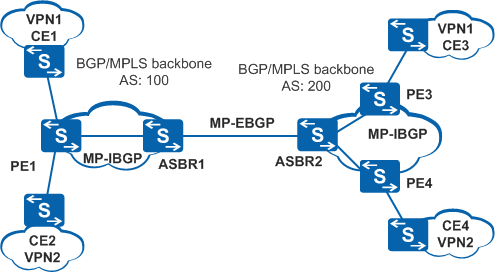(Optional) Enabling Next-Hop-based Label Allocation on the ASBR
Context
In an inter-AS VPN Option B scenario, ASBRs can be enabled to allocate labels to VPN routes based on next hops. This saves labels on the ASBRs.
Next-hop-based label allocation means to allocate the same label for the routes with the same forwarding behavior. In other words, VPN routes with the same forwarding path and outbound label are assigned the same label. Different from the prefix-based label allocation mode that is used by default, next-hop-based label allocation enrich the label allocation modes and allows for flexible label allocation. In addition, when an ASBR functions as a PE device, next-hop-based label allocation can be used together with one label per instance mode to save labels on the ASBR.

After next-hop-based label allocation is enabled or disabled, the label allocated by the ASBR for a route changes, which leads to packet loss.
Perform the following steps on the ASBR.
